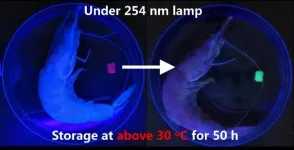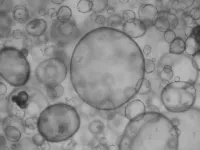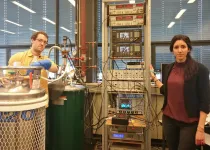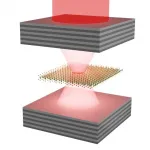By age 10, retinoblastoma patients' learning and life skills rebound
St. Jude Children's Research Hospital researchers studied how retinoblastoma survivors fared years later at home and at school.
2021-05-06
(Press-News.org) Retinoblastoma starts in the retina, the thin membrane at the back of the eye. Most patients are infants or toddlers when their cancer is found. Without treatment, the cancer spreads. Thanks to chemotherapy, surgery and other treatments, 96% of patients survive.
St. Jude researchers studied how survivors fared years later at home and at school. A previous St. Jude study of 98 retinoblastoma survivors found that their early learning and life skills declined from diagnosis to age 5.
Researchers tested 78 of the same survivors five years later. The results were more upbeat. By age 10, almost all the children functioned within the normal range in those areas. That included children who had one eye removed, although they did not make up quite as much ground in the areas of learning, thinking and memory.
"The good news is that as a group the children did improve over time, but not everyone is recovering at the same rate," said Victoria Willard, PhD, of St. Jude Psychology. "The findings show we all need to be aware of factors that put children at risk for difficulties later. It highlights that all young children with retinoblastoma may benefit from early intervention to promote growth and development."
The Journal of Clinical Oncology published a report on this work.
INFORMATION:
[Attachments] See images for this press release:

ELSE PRESS RELEASES FROM THIS DATE:
2021-05-06
Asthma attacks account for almost 50 percent of the cost of asthma care which totals $80 billion each year in the United States. Asthma is more severe in Black and Hispanic/Latinx patients, with double the rates of attacks and hospitalizations as the general population.
When the COVID-19 pandemic swept over the United States, a series of reports suggested that fewer people were coming to emergency departments for all sorts of medical problems, including asthma attacks and even heart attacks. In the case of asthma, it was not clear if the drop was due to people avoiding emergency services or due to better asthma control. A new analysis from investigators at Brigham and Women's Hospital shines new light on this question. In a report of ...
2021-05-06
Vaccination dramatically reduced COVID-19 symptomatic and asymptomatic infections in St. Jude Children's Research Hospital employees compared with their unvaccinated peers, according to a research letter that appears today in the Journal of the American Medical Association.
The study is among the first to show an association between COVID-19 vaccination and fewer asymptomatic infections. When the Pfizer-BioNTech BNT162b2 vaccine was authorized for use in the U.S., the vaccine was reported to be highly effective at preventing laboratory-confirmed COVID-19. Clinical trial data suggested that the two-dose regimen ...
2021-05-06
New research combines cutting-edge engineering with animal behaviour to explain the origins of efficient swimming in Nature's underwater acrobats: Seals and Sea Lions.
Seals and sea lions are fast swimming ocean predators that use their flippers to literally fly through the water. But not all seals are the same: some swim with their front flippers while others propel themselves with their back feet.
In Australia, we have fur seals and sea lions that have wing-like front flippers specialised for swimming, while in the Northern Hemisphere, grey and harbor seals have stubby, clawed paws and swim with their feet. But the reasons ...
2021-05-06
Sea turtles are known for relying on magnetic signatures to find their way across thousands of miles to the very beaches where they hatched. Now, researchers reporting in the journal Current Biology on May 6 have some of the first solid evidence that sharks also rely on magnetic fields for their long-distance forays across the sea.
"It had been unresolved how sharks managed to successfully navigate during migration to targeted locations," said Save Our Seas Foundation project leader Bryan Keller, also of Florida State University Coastal and Marine Laboratory. "This research supports the theory that they use the earth's magnetic field to help them find their way; it's nature's GPS."
Researchers ...
2021-05-06
Scientists in China and Germany have designed an artificial color-changing material that mimics chameleon skin, with luminogens (molecules that make crystals glow) organized into different core and shell hydrogel layers instead of one uniform matrix. The findings, published May 6 in the journal Cell Reports Physical Science, demonstrate that a two-luminogen hydrogel chemosensor developed with this design can detect seafood freshness by changing color in response to amine vapors released by microbes as fish spoils. The material may also be used to advance the development of stretchable electronics, dynamic camouflaging robots, and anticounterfeiting technologies.
"This novel core-shell layout does not require a careful choice of luminogen pairs, nor does it require an ...
2021-05-06
Mini-organs or organoids play a big role in the future of medicine. Their countless applications can help develop and implement tailored therapies for each patient. The revolutionary development of organoids started in Utrecht with a group of curious scientists. But when organoid research starting booming, confusion arose. What exactly is an organoid? Are there different types, and if so, what should they be called? A group of experts from around the world now publishes the first consensus on what is - and what is not - an organoid.
Bart Spee, Associate Professor at Utrecht University's faculty of Veterinary Medicine, is ...
2021-05-06
The "Third Pole" of the Earth, the high mountain ranges of Asia, bears the largest number of glaciers outside the polar regions. A Sino-Swiss research team has revealed the dramatic increase in flood risk that could occur across Earth's icy Third Pole in response to ongoing climate change. Focusing on the threat from new lakes forming in front of rapidly retreating glaciers, a team, led by researchers from the University of Geneva (UNIGE), Switzerland, demonstrated that the related flood risk to communities and their infrastructure could almost triple. ...
2021-05-06
New research by Joseph Wu, Edgar Engelman, and colleagues at Stanford University, US has advanced an old concept to develop a new strategy to train the immune system of mice to recognize cancer cells. This work is based on the recent understanding that induced pluripotent stem cells (iPSCs), which are stem cells generated from skin or blood cells through a method called reprogramming, produce a large set of antigens that have overlap to a specific type of pancreatic cancer and that these similarities can be used for potential clinical benefit.
It is well known that vaccines can be highly effective ...
2021-05-06
In spintronics, the magnetic moment of electrons (spin) is used to transfer and manipulate information. An ultra-compact 2D spin-logic circuitry could be built from 2D materials that can transport the spin information over long distances and also provide strong spin-polarization of charge current. Experiments by physicists at the University of Groningen (The Netherlands) and Colombia University (USA) suggest that magnetic graphene can be the ultimate choice for these 2D spin-logic devices as it efficiently converts charge to spin current and can transfer this strong spin-polarization ...
2021-05-06
At extremely low temperatures, matter often behaves differently than in normal conditions. At temperatures only a few degrees above absolute zero (-273 degrees Celsius), physical particles may give up their independence and merge for a short time into a single object in which all the particles share the same properties. Such structures are known as Bose-Einstein Condensates, and they represent a special aggregate state of matter.
An international team of researchers led by physicists Dr Carlos Anton-Solanas and Professor Christian Schneider from the UNiversity of Oldenburg has now succeeded for the first time in generating this unusual quantum state in charge carrier complexes that are closely linked ...
LAST 30 PRESS RELEASES:
[Press-News.org] By age 10, retinoblastoma patients' learning and life skills rebound
St. Jude Children's Research Hospital researchers studied how retinoblastoma survivors fared years later at home and at school.






